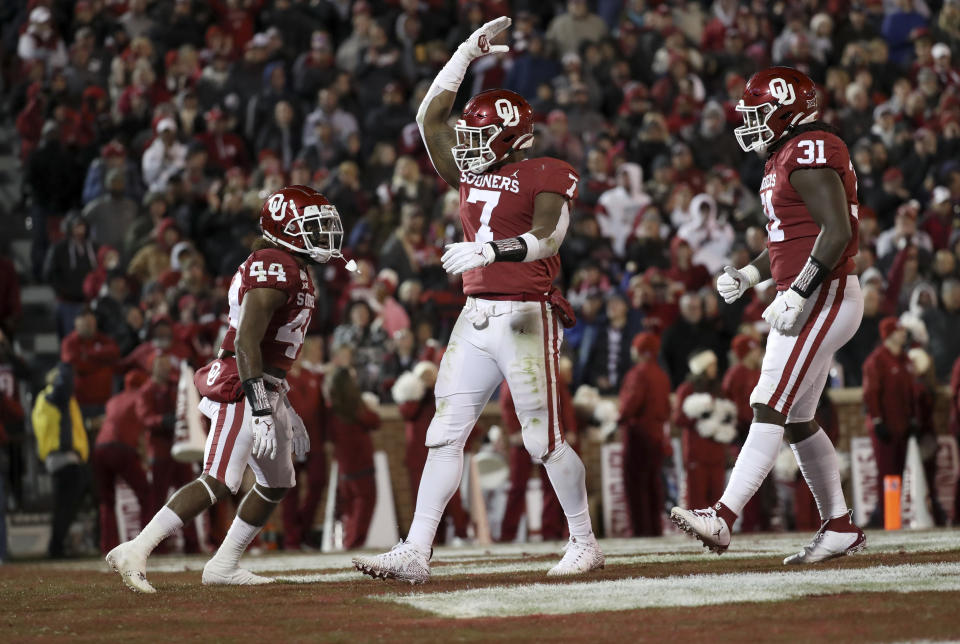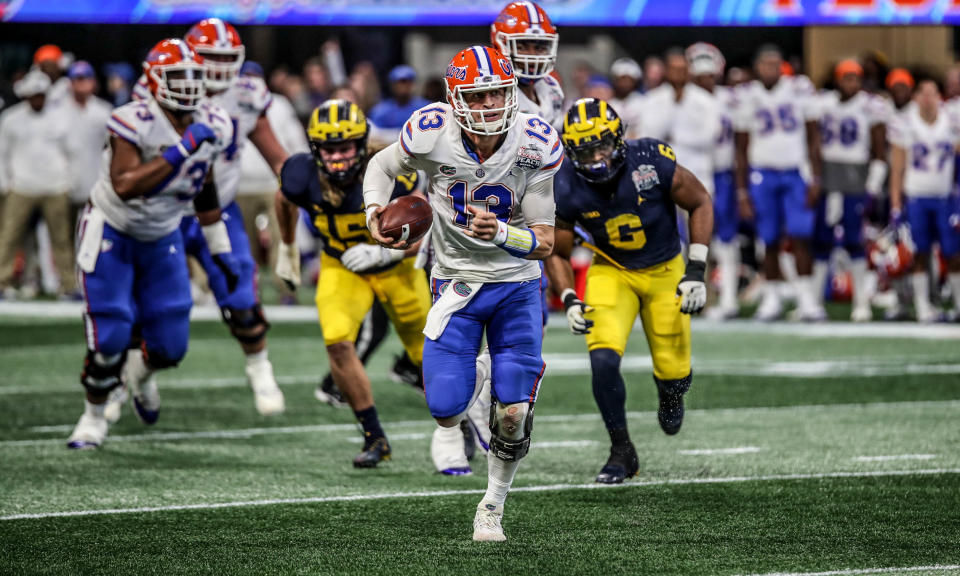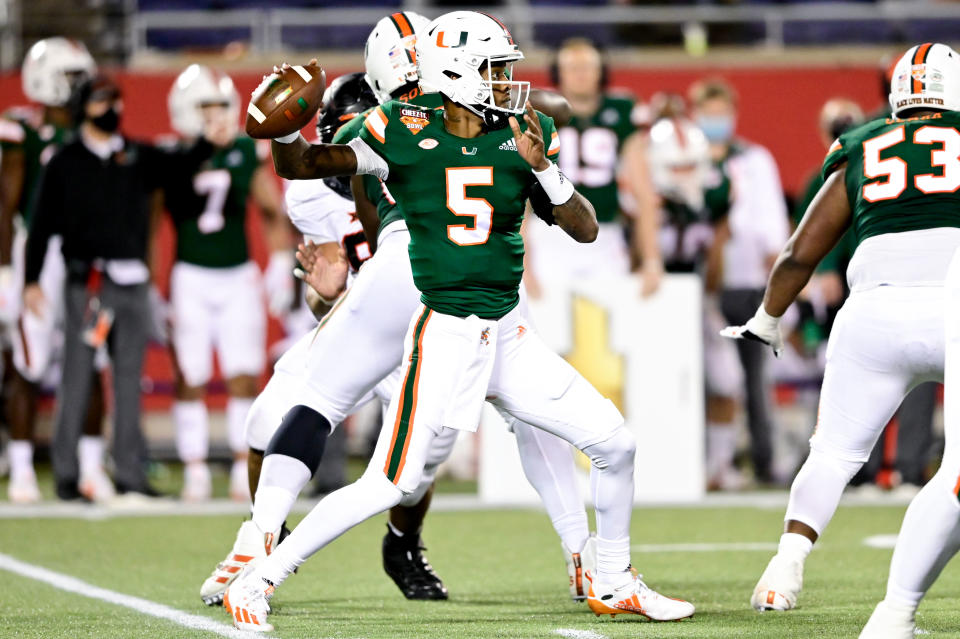What if? Who would be in a 30-team college football mega-conference?

Texas and Oklahoma are potentially blowing up the college football world by departing the Big 12 with eyes on joining the SEC, causing many across the sport to infer that we’re going to end up with one big super conference.
But what would that look like if it were to come to fruition? How many teams would be involved?
I’d heard the number 30 bandied about, so in creating a framework for one big ‘megaconference’ that’s what I went with. I split the nation into regions, going with the pod system. In my vision, I went with six divisions of five teams. Each team would play each other once a year, and would also play one team from each of the other five conferences to round out the nine-game conference schedule. There would still be three nonconference games that would allow some flexibility and to protect some longstanding rivalries including teams that wouldn’t make the cut for the megaconference.
Here’s how the country would be split up on the map:

Yes, there is some concentration in the southern regions of the United States, but with states such as Florida or Texas having multiple schools, it makes sense to pair them all together.
So, with that in mind, did your school make the cut for my hypothetical megaconference? See below, where I’ve included all 30 teams, what division they’d be in and why I chose them to be a part of college football’s new elite.
List
10 schools it would make sense for the Big Ten to add

Boise State (West Coast Division)

Photo: Brian Losness-USA TODAY Sports
There are only three Group of 5 schools included in this vision of the 'megaconference,' and I included Boise State due to the program deserving a seat at the table after the past decade-plus of success. We've seen the Broncos win New Year's Six bowls, take down powerhouses and generally fare well against their Power Five counterparts. It's time to include Boise State in the fray.
Oregon (West Coast Division)

Photo: The Register Guard
While the Ducks have had some waning moments in recent history, particular after a couple of years of Mark Helfrich, even in moments under Helfrich, Oregon has been one of the nation's best. Iconic in the ever-changing Nike uniforms, Oregon has long been a big draw for recruits and is an obvious choice to represent the West Coast in our megaconference.
Stanford (West Coast Division)

Photo: Joe Nicholson-USA TODAY Sports
Stanford was one of my last additions to the West Coast Division, and I was very close to leaving the Cardinal off. While I debated between Stanford and Arizona State -- especially considering that the Palo Alto program wasn't exactly humming along before Jim Harbaugh arrived in the 2000s -- the more recent perception of the Cardinal as a powerhouse convinced me to include David Shaw's team.
USC (West Coast Division)

Photo: Jayne Kamin-Oncea-USA TODAY Sports
USC was literally the first school I wrote down when coming up with this idea. While the Trojans have wandered the wilderness for a bit, Southern Cal still has a ton of recruiting cache and was the utmost dominant program in the aughts decade. USC is a blueblood, one of the centerpieces of the megaconference idea, and certainly the most valuable program in the West Coast.
Washington (West Coast Divison)

Photo: Joe Nicholson-USA TODAY Sports
Finishing up the West Coast Conference is Washington, a traditional powerhouse that has had some ups and downs in recent decades. The Huskies, along with USC, were probably the preeminent Pacific Coast school for quite some time. Though the luster wore off, once Steve Sarkisian and then Chris Petersen revived the program, it's been on the rise. Washington even made a College Football Playoff appearance in 2016. It's a no-brainer to include the Seattle-based program in the megaconference.
Iowa (Midwest Division)

Photo: Jeff Hanisch-USA TODAY Sports
I wasn't sure whether or not to include Iowa, even though it's been one of the Big Ten's most consistent teams under Kirk Ferentz. But the Hawkeyes are profitable and have a geographic location that makes it a perfect fit in our Midwest Division. Iowa has its ups and downs, but it's more likely to be up than anything.
Nebraska (Midwest Division)

Photo: Dylan Widger-USA TODAY Sports
While Nebraska hasn't exactly done much of anything since joining the Big Ten, the Cornhuskers are a blueblood and had to be included in the megaconference. It has natural rivals geographically with Iowa and Oklahoma, and now it could play both every year being in the same division.
Oklahoma (Midwest Division)

Photo: Kevin Jairaj-USA TODAY Sports
Spoiler alert: I did split up Texas and Oklahoma, perhaps to punish the schools for teaming up in the current Big 12 split debacle. But more so because it fits more naturally in the Midwest Division, going up against the likes of schools like Nebraska and Iowa. Of course, adding the Sooners was a no-brainer, overall. Of course, the Red River Rivalry could still take place annually as a protected crossover game.
Oklahoma State (Midwest Division)

Photo: Tim Heitman-USA TODAY Sports
Bedlam is still on, thanks to the addition of Oklahoma State. Really, the Big 12 didn't have a lot of schools to choose from and the Cowboys were the third and final selection I made from said conference. OSU has been deserving, generally fielding a team that's in contention late into the season every year, and it has a rich history of producing some of the finest players to ever partake in the sport.
Wisconsin (Midwest Division)

Photo: Jeff Hanisch-USA TODAY Sports
The hardest part for me was to pare down each pod to just five teams while making everything make sense geographically. Wisconsin is a natural fit either in the North or the Midwest, but I included it in the Midwest Division because I think it makes more sense being a middle of the country-type team. Regardless, the Badgers were going to make the cut no matter what as one of the Big Ten's most formidable teams for decades.
Cincinnati (North Division)

Photo: Isaiah Hole
Our second entry from the Group of 5, Cincinnati deserves to be in one of the bigger conferences. Sure, it isn't a big moneymaker, but the Bearcats have long been the class of the American Conference and generally has been a coach-feeder for Power Five schools. No longer, as now Cincinnati is playing with the big dogs. And the Bearcats' inclusion gives Ohio State another rival.
Michigan (North Division)

Photo: Isaiah Hole
One of the most profitable schools in the country that also happens to be a blueblood. Yes, Michigan has had its struggles, but even after 2020's 2-4 debacle, Jim Harbaugh's tenure is one of the best in college football from a win percentage standpoint. No, the Wolverines haven't been winning bowl games, but they have made it to two New Year's Six games and has beaten Florida twice in Harbaugh's tenure.
Michigan State (North Division)

Photo: Isaiah Hole
It took me a minute to decide whether or not to include the Spartans here, as they've been mostly struggling the past few years, but MSU is only a few years removed from a College Football Playoff appearance and won the Big Ten multiple times in the past decade. Also, it's a profitable program and including Michigan State keeps the battle for the Paul Bunyan Trophy ongoing.
Notre Dame (North Division)

Photo: Quinn Harris-USA TODAY Sports
Sorry, Notre Dame -- you had to finally join a conference. Another blueblood that will now have big matchups every year against the big regional teams, the Fighting Irish are an obvious choice to be both in the megaconference as well as in the North Division. Plus, it could have some of its rivals as protected in-conference crossovers (if it wants to keep both USC and Stanford) while playing its other rivals in nonconference.
Ohio State (North Division)

Photo: USA TODAY Sports
I toyed with putting Ohio State in the South Division, but it made more sense keeping the Buckeyes up north (certainly that phrase will rankle some feathers). OSU was obviously going to be placed somewhere, and it makes more sense having it play Michigan, Notre Dame, Cincinnati and MSU every year rather than putting it elsewhere.
Alabama (Midsouth Division)

Photo: Isaiah Hole
The SEC is officially broken up and some of its members have ended up in the newly minted 'Midsouth Division.' Alabama makes sense here as it could contend against some of the regional rivalries while adding the state of Texas to its division. Naturally, the Crimson Tide are the centerpiece of the Midsouth.
Auburn (Midsouth Division)

[Staff Photo/Gary Cosby Jr.]
The Alabama-Auburn rivalry continues as an interdivisional matchup, because like with Michigan-Ohio State, I couldn't split the pair up. The Tigers are one of the most profitable programs in college football, which also meant I couldn't leave them off the list.
LSU (Midsouth Division)

Photo: Stephen Lew-USA TODAY Sports
This might be the most fun division of all, as we not only get Alabama and Auburn (and the Texas teams, as you'll soon see), but LSU as well. The other Tigers in the Midsouth, LSU has been one of the most dominant programs in the country and a cornerstone of SEC football the past few decades.
Texas (Midsouth Division)

(AP Photo/Eric Gay)
Congratulations, Texas -- you made your bed, now you have to lie in it. The reason we're even talking about a megaconference in the first place is because of Texas' decision to depart the Big 12, where it at least had a serviceable path to the College Football Playoff. Now it's paired with some of the most elite programs in the country, which it will have to face on a yearly basis. So, good luck Longhorns -- if you're going to win your division, you'll have earned it.
Texas A&M (Midsouth Division)

Photo: Sam Navarro-USA TODAY Sports
First off, apologies to Texas A&M, because it's tried to hard to get away from Texas and yet can't. And now it really can't due to Texas (and Oklahoma)'s meddling with the college football landscape. The Aggies, along with the Longhorns, are among the most profitable programs in all of college football and have seemingly been on the rise since joining the SEC. It'll still have to contend with thorns Alabama and LSU, but it probably has a better chance to emerge from the division than Texas at this juncture. So -- silver linings?
Florida (South Division)

Photo: Isaiah Hole
Florida now gets to partake in a hyper-regional division where it will face off mostly against teams in its own state. The Gators are one of two centerpieces in the South Division which encompasses all of Florida and the sole representative from Georgia. Overall, this could be a very evenly-pared division.
Florida State (South Division)

Photo: Isaiah Hole
After making the first College Football Playoff a year after winning the national championship, the Seminoles have been all but irrelevant. It makes no sense given that Florida State hasn't stopped recruiting. But now, it really could take things up a notch, having to face off against some of the nation's best. Seeing games like Florida State vs. Georgia could be fun if FSU holds up its end of the bargain.
Georgia (South Division)

(Photo by Kevin C. Cox/Getty Images)
The Bulldogs are the other centerpiece in the South Division, and what fun it will be to continue seeing the Florida-Georgia rivalry every year, as well as seeing UGA go up against Florida State and Miami on an annual basis. While I would have liked to have (finally) gotten Georgia into the same division as Alabama, this made more sense geographically.
Miami (South Division)

Photo: Douglas DeFelice-USA TODAY Sports
Miami has been a program on the cusp of returning to the college football elite, but hasn't quite gotten there yet. Its storied history is reserved for the late-1970s-2000s, but it's one of the winningest programs when it comes to national championships in all of college football. With the South Division, we'd get to see an annual Florida-Miami matchup to go along with the other enticing interdivisional games. The Hurricanes continue to be intriguing and its placement in the megaconference only make them more so.
UCF (South Division)

Photo: Isaiah Hole
Surprise! The final Group of 5 team to enter the fray is none other than the self-proclaimed national championship winners. UCF really has only come onto the scene as of late, but the school has the nation's largest student body and deserves a seat at the table for what it's been able to do the last few years. Now, it will really get a chance to see what it can do, having to play Florida, Florida State, Georgia and Miami every year rather than breezing through the American Conference.
Clemson (East Coast Division)

Kevin Jairaj-USA TODAY Sports
There was no doubt that one of the perennial College Football Playoff participants was going to make the cut, and in doing so, Clemson is the centerpiece of the East Coast Division. But now, the Tigers will have to play a few teams that might be a little better than what they've seen in the ACC.
Penn State (East Coast Division)

Photo: Isaiah Hole
I wasn't crazy about taking Penn State away from its Big Ten foes, but from a geographical standpoint, being in the East Coast Division is a better fit. It might not have to play Michigan and Ohio State every year, but now the Nittany Lions have to square off against Clemson annually. Perhaps an even trade.
South Carolina (East Coast Division)

Photo: Isaiah Hole
I wasn't aware of this before writing this list up, but South Carolina is among the most profitable programs in all of college football. That alone was reason enough to include the Gamecocks, but also having a natural in-state rivalry with Clemson put it over the top. The other USC hasn't exactly been formidable, but it's been stuck in the SEC where it's been difficult to get over the hump. Perhaps the East Coast Division would have more parity.
Tennessee (East Coast Division)

(Photo by Joe Robbins/Getty Images)
The Volunteers aren't naturally situated in the East Coast, but this is where I could fit them best. Tennessee would get to continue playing its current divisional foe in South Carolina while also adding Penn State, Clemson and neighboring Virginia Tech to the mix. The Vols have blueblood status but haven't shown much since the 2000s.
Virginia Tech (East Coast Division)

Photo: Charles LeClaire-USA TODAY Sports
I was between North Carolina and Virginia Tech for the final spot, but the Hokies won out because they've had greater overall success in the past 20-some years compared to the now-surging Tar Heels. No, Va. Tech hasn't quite been what it was under Frank Beamer, but it has long been looked at as one of the better schools in college football. It would still have to play Clemson, but adds some other interesting matchups into the mix.
Full breakdown by division
West Coast
USC
Oregon
Washington
Boise State
Stanford
Midwest
Iowa
Nebraska
Oklahoma
Oklahoma State
Wisconsin
North
Michigan
Ohio State
Cincinnati
Michigan State
Notre Dame
Midsouth
Texas
Texas A&M
Alabama
Auburn
LSU
South
Florida
Florida State
Miami
UCF
Georgia
East Coast
Clemson
South Carolina
Penn State
Tennessee
Virginia Tech
1
1

